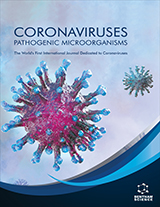Abstract
Corona Virus Disease 2019 (COVID-19) is reported to be transmitted predominantly by respiratory droplets and fomites. The regular use of a mask can mitigate the airborne transmission of the Severe Acute Respiratory Syndrome Corona Virus-2 (SARS-CoV-2), but comprehensive prevention of the virus is possible only when the contact spread of the virus is also addressed. The recommended use of soap and hand sanitizer (alcoholic hand rub) is effective only until subsequent contact with the virus. Furthermore, regular and repeated application of these disinfectants is impractical and harmful to the skin. The damage to the outermost epidermal layers of the skin exposes the Angiotensin-converting enzyme 2 (ACE2) receptor rich keratinocytes, enhancing the scope for percutaneous transmission of virus. Moisturizers, composed of fatty acids, fatty alcohols, mineral oils, petrolatum, etc., are generally considered cosmetics used to maintain and enhance skin condition. At very low concentrations, several of these components are found to neutralize enveloped viruses, indicating their potential antiviral activity. Soaps also generally contain many of these constituents, making them effective against viruses. Petrolatum, a key component of occlusive moisturizers, is also said to enhance innate immunity. Additionally, moisturizers also alleviate inflammation and prevent skin dryness and damage. The periodic and regular application of an appropriate moisturizer on hand and palm can play a significant role in curtailing the transmission of infectious agents, including (SARS-CoV-2), and could act as an extra line of defense against microbial infections.
Graphical Abstract
[http://dx.doi.org/10.1016/j.antiviral.2020.104742] [PMID: 32057769]
[http://dx.doi.org/10.1056/NEJMoa2001017] [PMID: 31978945]
[http://dx.doi.org/10.1126/science.abb2507] [PMID: 32075877]
[http://dx.doi.org/10.1016/j.coviro.2018.01.001] [PMID: 29452994]
[PMID: 31908772]
[http://dx.doi.org/10.1017/S0950268820002563] [PMID: 33092672]
[http://dx.doi.org/10.1038/s41598-021-00843-0] [PMID: 34819522]
[http://dx.doi.org/10.1080/22221751.2020.1858177] [PMID: 33251966]
[http://dx.doi.org/10.1016/j.ajic.2014.10.015] [PMID: 25637115]
[http://dx.doi.org/10.1056/NEJMc2004973] [PMID: 32182409]
[http://dx.doi.org/10.1016/j.jhin.2020.01.022] [PMID: 32035997]
[http://dx.doi.org/10.1186/s12985-020-01418-7] [PMID: 33028356]
[http://dx.doi.org/10.1046/j.1365-2672.2002.01734.x] [PMID: 12234341]
[http://dx.doi.org/10.1046/j.1537-2995.1985.25686071422.x] [PMID: 3934801]
[http://dx.doi.org/10.1006/biol.2002.0334] [PMID: 12127317]
[http://dx.doi.org/10.1128/AAC.33.12.2034] [PMID: 2619271]
[http://dx.doi.org/10.1086/595845] [PMID: 19115974]
[http://dx.doi.org/10.1128/AEM.01729-09] [PMID: 19933337]
[http://dx.doi.org/10.1111/j.1468-3083.2005.01326.x] [PMID: 16268870]
[http://dx.doi.org/10.1016/j.clindermatol.2011.08.015] [PMID: 22507043]
[http://dx.doi.org/10.1159/000493641] [PMID: 30336483]
[http://dx.doi.org/10.3121/cmr.2017.1363] [PMID: 29229630]
[PMID: 4120354]
[http://dx.doi.org/10.1128/AAC.31.1.27] [PMID: 3032090]
[http://dx.doi.org/10.1002/(SICI)1096-9071(200002)60:2<182:AID-JMV13>3.0.CO;2-Y] [PMID: 10596019]
[http://dx.doi.org/10.1086/506948] [PMID: 16941346]
[http://dx.doi.org/10.1007/s00705-007-1063-5] [PMID: 17891329]
[PMID: 20224147]
[http://dx.doi.org/10.1016/j.jaci.2015.08.013] [PMID: 26431582]
[http://dx.doi.org/10.1016/j.bbamem.2016.01.002] [PMID: 26777770]
[http://dx.doi.org/10.1111/jdv.15944] [PMID: 31588615]
[http://dx.doi.org/10.1097/DER.0000000000000429] [PMID: 30570578]
[http://dx.doi.org/10.1128/AAC.11.1.98] [PMID: 189684]
[http://dx.doi.org/10.1016/j.cell.2018.02.054] [PMID: 29522750]
[http://dx.doi.org/10.3390/pathogens10020227] [PMID: 33670736]
[http://dx.doi.org/10.1371/journal.pntd.0008831] [PMID: 33166294]
[http://dx.doi.org/10.1101/2022.01.18.476607]
[http://dx.doi.org/10.7717/peerj.12041] [PMID: 34616601]
[http://dx.doi.org/10.1016/j.jid.2020.05.087] [PMID: 32454066]
[http://dx.doi.org/10.1111/dth.13310] [PMID: 32170800]
[http://dx.doi.org/10.1016/0190-9622(92)70060-S] [PMID: 1564142]
[http://dx.doi.org/10.1007/BF00373429] [PMID: 7625857]
[http://dx.doi.org/10.37358/RC.19.7.7355]
[http://dx.doi.org/10.1021/ed061p1060]
[http://dx.doi.org/10.1128/AAC.15.1.67] [PMID: 218499]
[http://dx.doi.org/10.1128/AAC.15.1.134] [PMID: 218498]
[http://dx.doi.org/10.1099/jgv.0.001472] [PMID: 32692647]
[http://dx.doi.org/10.1016/j.arcmed.2020.03.004] [PMID: 32229155]
[http://dx.doi.org/10.1172/JCI108468] [PMID: 956366]
[http://dx.doi.org/10.1111/j.1600-0463.2005.apm1130109.x] [PMID: 15676016]
[http://dx.doi.org/10.1038/s41598-021-84850-1] [PMID: 33664446]
[http://dx.doi.org/10.1126/science.abd3255] [PMID: 32958580]
[http://dx.doi.org/10.3390/molecules26030711] [PMID: 33573088]
[http://dx.doi.org/10.1016/0305-4179(94)90096-5] [PMID: 8198750]
[http://dx.doi.org/10.1016/0305-4179(95)00006-2] [PMID: 7546258]
[http://dx.doi.org/10.1007/s12560-021-09485-x] [PMID: 34173934]
[http://dx.doi.org/10.1093/infdis/152.2.400] [PMID: 2993438]
[http://dx.doi.org/10.1111/j.1472-765X.1994.tb00820.x] [PMID: 7764595]
[PMID: 18813862]
[http://dx.doi.org/10.3892/etm.2010.139] [PMID: 22993629]
[http://dx.doi.org/10.1371/journal.pone.0052738] [PMID: 23300756]
[http://dx.doi.org/10.1128/JVI.02243-12] [PMID: 23637403]
[http://dx.doi.org/10.1128/JVI.79.22.14318-14329.2005] [PMID: 16254366]
[http://dx.doi.org/10.1186/s12985-018-1035-2] [PMID: 30089512]
[http://dx.doi.org/10.1074/jbc.M710415200] [PMID: 18567888]
[http://dx.doi.org/10.1016/j.imbio.2019.05.004] [PMID: 31126693]
[PMID: 35576549]



























